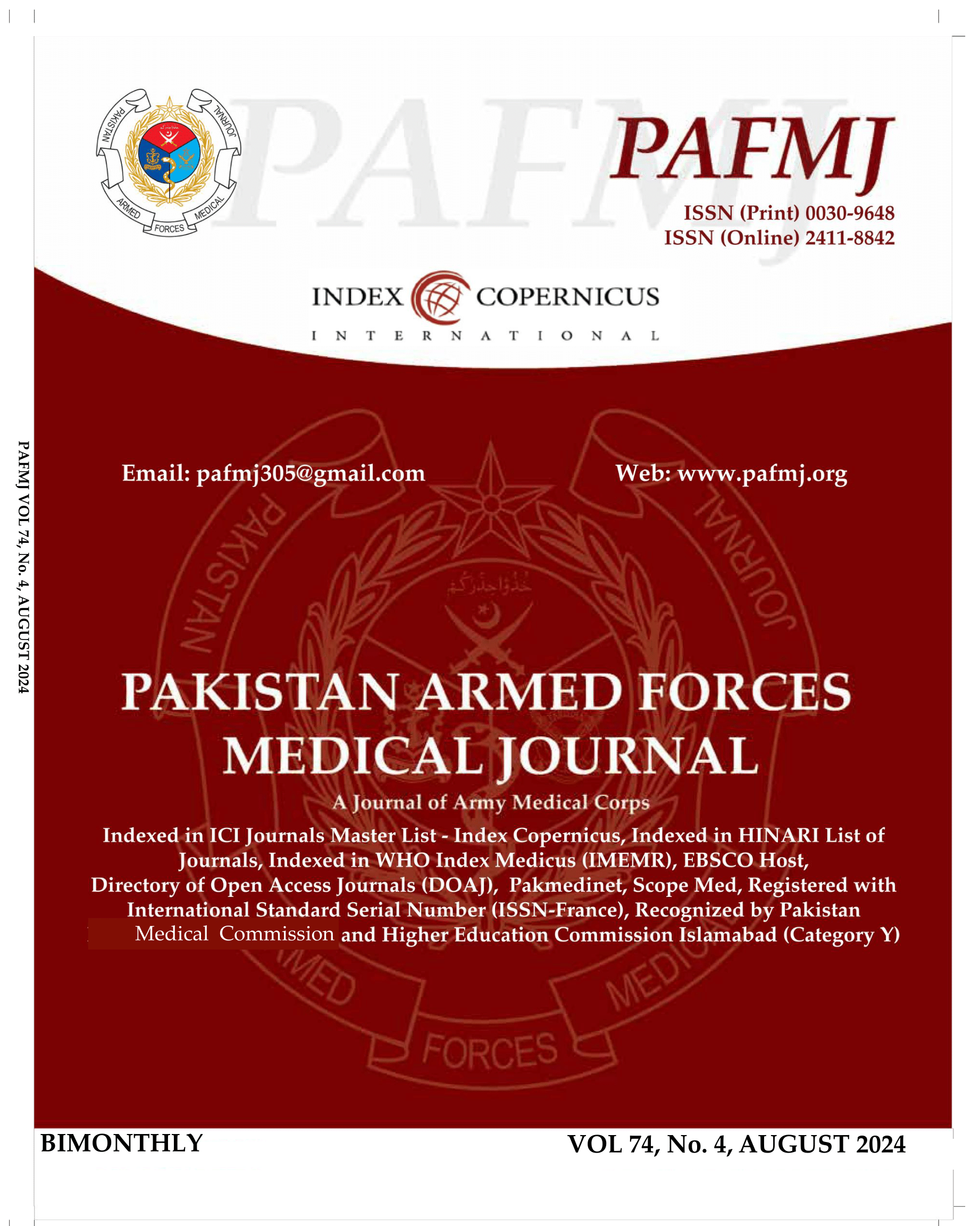Four Years Maternal Missed Mortality Ratio and Mortality Index at A Tertiary Care Hospital in Azad Kashmir
DOI:
https://doi.org/10.51253/pafmj.v74i4.9359Keywords:
Eclampsia, Hemorrhage, Maternal Mortality, MorbidityAbstract
Objective: To calculate the Maternal Near Miss Mortality Ratio and Mortality Index at a tertiary care hospital in a developing country with limited healthcare resources.
Study Design: Retrospective analytical study.
Place and Duration of Study: Department of Gynecology and Obstetrics, Shaikh Khalifa Bin Zayed Al Nahyan Hospital Azad Kashmir and Combined Military Hospital, Muzaffarabad Pakistan, from Jan 2015 to Dec 2018.
Methodology: Four hundred and forty-nine severe maternal outcome cases admitted in Intensive Care Unit were included in our study. Maternal Near Miss Mortality Ratio and Mortality Index were calculated. SPSS version 23.00 used for statistical analysis.
Results: The maternal near missed mortality ratio was 11:1, mortality index 8.68%, severe maternal outcome 1.58% with 39 maternal deaths. Most common causes of maternal morbidity were hemorrhage (56.1%); hypertensive disorders (24%); sepsis (3.5%) and cardiovascular diseases (1.8%). Hypertensive disorders of pregnancy (30.7%), hemorrhage (25.6%) and sepsis (25.6%) were the common causes of maternal deaths. The total ICU time in patient with near-miss was 1.9±1.7 days versus 2.6±3.14 days in deaths, p<0.001. Operative delivery was statistically significantly (p value <0.001) more common mode of delivery in severe maternal outcomes (66.6%) and maternal deaths (33.3%).
Conclusion: Our study has shown 1.58% severe maternal outcomes amongst admitted pregnant, maternal near missed mortality ratio being 11:1, mortality index being 8.68%. Eclampsia, hemorrhage and sepsis are major cause of maternal death.
Downloads
References
Rehman S, Jeelani K. Analysis of maternal mortality in Jammu and Kashmir: a retrospective study based on review of field data. Asian J Med Sci 2022; 13(4): 56-61.
https://doi.org/10.3126/ajms.v13i4.41351
Shaeen SK, Tharwari ZH, Bilal W, Islam Z, Essar MY. Maternal mortality in Pakistan: challenges, efforts and recommendations. Ann Med Surg 2022; 81: 104380.
https://doi.org/10.1016/j.amsu.2022.104380
Geller SE, Koch AR, Garland CE, MacDonald EJ, Storey F, Lawton B. A global view of severe maternal morbidity: moving beyond maternal mortality. Reprod Health 2018; 22(15): 98. https://doi.org/10.1186/s12978-018-0527-2
Centers for Disease Control and Prevention. Severe maternal morbidity indicators and corresponding icd codes during delivery hospitalization. 2017.
Egal JA, Kiruja J, Litorp H, Osman F, Erlandsson K, Klingberg-Alvin M. Incidence and causes of severe maternal outcomes in somaliland using sub-saharan african maternal near-miss criteria: a prospective cross-sectional study in a national referral hospital. Int J Gynaecol Obstet 2022; 159(3): 856-864.
https://doi.org/10.1002/ijgo.14236
Venkatesh S, Chinmayi, Ramkumar V, Sheela CN, Thomas A. Implementation of who near-miss approach for maternal health at a tertiary care hospital: an audit. J Obstet Gynaecol Ind 2016; 66(4): 259-262.
https://doi.org/10.1007/s13224-015-0684-y
Souza JP. Maternal Near Miss. WHO Department Of Reproductive Health And Research. Training Course in Sexual and Reproductive Health Research. Geneva 2011.
Chikadaya H, Madzivire MG, Muniania SP. Incidence Of Maternal Near Miss in the Public Health Sector of Harare, Zimbabwe: A Prospective Descriptive Study. BMC Pregnancy Childbirth 2018; 18:458: 1-6.
https://doi.org/10.1186/s12884-018-2092-7
Kulkarni R, Kshirsagar H, Begum S, Patil A, Chauhan S. Maternal near miss events in India. Indian J Med Res 2021; 154(4): 573-582.
https://doi.org/10.4103/ijmr.IJMR_928_19.
Gupta D, Nandi A, Noor N, Joshi T, Bhargava M. Incidence of maternal near miss and mortality cases in Central India tertiary care center and evaluation of various causes. N Indian J Obgyn 2018; 4(2): 112-116.
https://doi.org/10.21276/obgyn.2018.4.2.4
de Lima THB, Katz L, Kassar SB, Amorim MM. Neonatal near miss determinants at a maternity hospital for high-risk pregnancy in Northeastern Brazil: a prospective study. BMC Pregnancy Childbirth 2018; 18(1): 401.
https://doi.org/10.1186/s12884-018-2020-x.
Tura AK, Zwart J, van Roosmalen J, Stekelenburg J, van den Akker T, Scherjon S. Severe maternal outcomes in Eastern Ethiopia: application of the adapted maternal near miss tool. PLoS One 2018; 13(11):
https://doi.org/10.1371/journal.pone.0207350
Beyene T, Chojenta C, Smith R, Loxton D. Severe maternal outcomes and quality of maternal health care in south Ethiopia. Int J Womens Health 2022. 3; 14: 119-130.
https://doi.org/10.2147/IJWH.S341912
CDC. Severe Maternal Morbidity in the United States. Centers for Disease Control and Prevention, 2023.
Mu Y, Wang X, Li X, Liu Z, Li M, Wang Y, et al. The national maternal near miss surveillance in China: a facility-based surveillance system covered 30 provinces. Medicine 2019; 98(44): e17679.
https://doi.org/10.1097/MD.0000000000017679
Oğlak SC. Tunç S, Obut M, Sekker E, Behram M, Tahaoğlu AE. Maternal near-miss patients and maternal mortality cases in a Turkish tertiary referral hospital. Ginekol Pol 2021; 92(4): 300-305.
https:doi.org/10.5603/GP.a2020.0187
Woldeyes WS, Asefa D, Muleta G. Incidence and determinants of severe maternal outcome in Jimma University teaching hospital, South-west Ethiopia: a prospective cross-sectional study. BMC Pregnancy Childbirth 2018; 18(1): 255.
https://doi.org/10.1186/s12884-018-1879-x.
Iqbal M, Muhammad Zia, Akhtar Z, Naz T. The three delays of maternal mortality in a teaching hospital. J Med Sci 2017; 25(2): 231-235.
MacDorman MF, Thoma M, Declercq E, Howell EA. Causes contributing to the excess maternal mortality risk for women 35 and over, United States, 2016-2017. PLoS One 2021; 16(6): e0253920. https://doi.org/10.1371/journal.pone.0253920
Restrepo-Méndez MC, Victora CG. Maternal mortality by age: who is most at risk? Lancet Glob Health 2014; 2(3): e120-e121. https://doi.org/10.1016/S2214-109X(14)70007-5
Yugi L, Tan G, Chengming S, Xuri S. The ICU is becoming a main battlefield for severe maternal rescue in China: an 8-year single-center clinical experience. Crit Care Med 2017; 45(11): e1106-e1110. https://doi.org/10.1097/CCM.0000000000002597
Mawarti Y, Utarini A, Hakimi M. Maternal care quality in near miss and maternal mortality in an academic public tertiary hospital in Yogyakarta, Indonesia: a retrospective cohort study. BMC Pregnancy Childbirth 2017; 17: 149.
Downloads
Published
Issue
Section
License
Copyright (c) 2024 Ambreen Ehsan, Maryam Zubair, Abida Islam, Amera Tariq, Umairah Yaqub, Nosheena Shabbir

This work is licensed under a Creative Commons Attribution-NonCommercial 4.0 International License.















